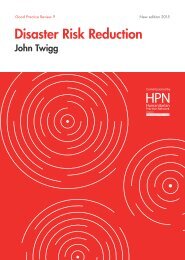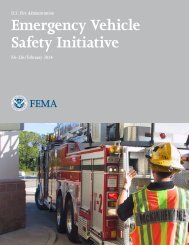Observer
2aEAQDf
2aEAQDf
Create successful ePaper yourself
Turn your PDF publications into a flip-book with our unique Google optimized e-Paper software.
ers was essentially passive: deploying the local Community<br />
Emergency Response Team (CERT) to distribute fliers<br />
with information pertaining to resources available at the<br />
FEMA-established base camp in Midland Beach. When<br />
resident after resident expressed bewilderment at being<br />
asked to leave their homes in order to present themselves<br />
to FEMA, the CERT team switched gears and began to deliver<br />
needed supplies directly to those affected. These early<br />
days and weeks of misunderstanding between residents<br />
and large organizations, at a time when people’s homes<br />
were so desperately in need of attention, resulted in crucial<br />
failures in resource distribution that persisted throughout<br />
the recovery process.<br />
In interpreting the ethnographic data gathered in my<br />
multi-year study of the aftermath of Sandy 2 , I have drawn<br />
on my own experience living and working on Staten Island<br />
for eight years, what I have learned from my close<br />
ties and daily observations of Staten Islanders of all descriptions.<br />
No significant literature exists on the culture<br />
of Staten Island. The local cultural insight required to<br />
analyze a localized recovery process can only come from<br />
purposefully and systematically engaging from the start<br />
with people who possess such local knowledge. It goes<br />
without saying that the problems described here are not<br />
limited to Staten Island or any single location. However,<br />
the experience of Staten Islanders with Sandy provides a<br />
good illustration of how potential cultural barriers manifest,<br />
even in an environment that responders and agencies<br />
may presume to be culturally similar to their own background.<br />
Cultural misunderstandings, and a general lack<br />
of attention to local culture by disaster-related agencies,<br />
has become an issue of much greater attention in recent<br />
years (see e.g. Browne 2015; Krüger, et al, 2015). But in<br />
practice agencies still struggle to incorporate local cultural<br />
understandings into their methods. This case—Sandy on<br />
Staten Island—will be used to illustrate how core cultural<br />
concepts can be utilized to better understand the impact of<br />
a disaster in a local community, and to pinpoint common<br />
areas of cultural gaps between this local community and<br />
disaster response and recovery institutions.<br />
Disasters in everyday life and culture<br />
It is easy to speak of culture in generalities, but difficult to<br />
define in practice, and even harder to operationalize. Even<br />
among anthropologists, who live and breathe culture,<br />
definitions and frameworks can vary. However, I will lay<br />
out here a few general principles that are very useful for<br />
speaking about culture with greater specificity and utility.<br />
This framework has multiple components, and in different<br />
situations, different aspects will be more significant than<br />
others.<br />
This framework is particularly useful in thinking about<br />
2 I began participant observation as an evacuee the day of the storm, and<br />
in the months that followed began formally collecting interviews from local<br />
residents on an ongoing basis as part of an undergraduate class on culture<br />
and research methods. This data collection is ongoing and longitudinal,<br />
and has been supplemented by further participant observation and focus<br />
groups with non-profit agencies, emergency responders (such as the local<br />
CERT team), and Disaster Case Managers (DCMs).<br />
Figure 1. A framework for thinking about culture. Adapted from Brown, 1991, Harris<br />
1964<br />
the role of culture in disasters, because unlike some frameworks,<br />
it considers the role of the environment in shaping<br />
culture. The figure suggests that the building blocks<br />
of culture (encompassing, for example, economics, social<br />
and family relations, and belief systems/ideologies) come<br />
into being through the needs of our brains to make sense<br />
of and adapt to our environment, and that although there<br />
is stability in culture, it is also an ongoing and dynamic<br />
process. Other important aspects of culture, for example,<br />
ritual behavior, are a kind of joint project of multiple layers,<br />
such as social organization and beliefs, though they<br />
may also be influenced by economy.<br />
Anthropologists have noted that in some societies, disasters,<br />
such as drought, have their place in the cultural<br />
framework of everyday life. Indeed, disasters may be “a<br />
normal part of the environment” in which people live (Mc-<br />
Cabe, 2002: p. 234; see also García-Acosta, 2002). In many<br />
cases, local cultural response systems provide the key to<br />
resilience in the face of disaster, especially when institutions<br />
fail to meet the needs of the affected communities<br />
(see Browne, 2015, the case of Hurricane Katrina). However,<br />
in cases where disaster is not built into the fabric of<br />
everyday life, and an underprepared local culture is challenged<br />
to accommodate and contextualize a major disaster,<br />
conflicts between these cultures and the cultures of<br />
disaster-response organizations can severely hamper the<br />
process of recovery, as well as hamper preparedness for<br />
future disasters.<br />
This was the case in 2012 in Staten Island, a place historically<br />
unfamiliar with the degree of havoc wrought by natural<br />
disasters such as Sandy. Some coastal residents were<br />
familiar with the regular ritual of small-scale basement<br />
flooding, for example. However, their familiarity gave the<br />
illusion that they could handle what was to come—waters<br />
that rose well above existing 100-year flood zones, wiping<br />
out entire neighborhoods. The failure to accurately evaluate<br />
and then accommodate the probable risks associated<br />
with the arrival of the storm, combined with the cultural<br />
conflicts between the residents and the institutions tasked<br />
with responding to their needs, very likely exacerbated<br />
the severity of the storm’s impact for many residents, both<br />
during and after the storm.<br />
Natural Hazards <strong>Observer</strong> • June 2016 11







